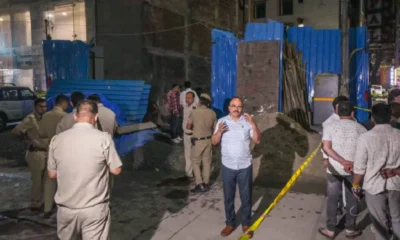News
‘Pakistan carried out several attacks using drones and ammunition, we are aware of this…’ Indian Army issued a statement giving information
Tension seems to be increasing once again on the India-Pakistan border. On the intervening night of 8 and 9 May, Pakistan attempted a coordinated drone attack on the western border, in which an attempt was made to target Indian military bases.

India Foils Major Drone Attack by Pakistan Along Western Border
New Delhi, May 9, 2025 — Tensions have once again escalated on the India-Pakistan border following a coordinated drone attack attempted by Pakistan on the intervening night of May 8 and 9. The Indian Armed Forces successfully intercepted and neutralized over 50 drones, preventing damage to key military installations and civilian areas.
According to the Indian Army, the attack targeted multiple military bases and strategic locations near the Line of Control (LoC) and International Border (IB) in Jammu & Kashmir, including Udhampur, Samba, Jammu, Akhnoor, Nagrota, and Pathankot.
Operation Sindoor: India Responds Decisively
Pakistan’s offensive included advanced drone swarms, munitions, and ceasefire violations (CFVs) along the LoC. Indian defense forces, using state-of-the-art air defense systems, radar networks, and coordinated tactical units, successfully intercepted every hostile drone.
The Indian Army described the action as part of its proactive defense under Operation Sindoor, reaffirming its commitment to protecting India’s sovereignty and territorial integrity.
“Any form of hostile activity will be responded to decisively and forcefully,” the Army’s official statement read.
Strategic Review Underway at the Highest Level
In response to these developments, Defence Minister Rajnath Singh has called a high-level emergency meeting. Attending the session are:
-
Chiefs of the Army, Air Force, and Navy
-
Chief of Defence Staff (CDS), General Anil Chauhan
-
Senior officials from the Defence Ministry and intelligence agencies
The meeting aims to assess the security situation, evaluate Pakistan’s military posture, and consider India’s next strategic moves. Sources indicate that the armed forces may receive directives for an escalated response if provocations continue.
Rising Border Provocations: A Pattern Emerges
Over the past few months, Pakistan has stepped up hostile activities along the border, including:
-
Drone infiltrations
-
Smuggling of arms and ammunition
-
Terrorist infiltration attempts
-
Repeated violations of the 2003 ceasefire agreement
Experts suggest these are part of Pakistan’s strategy to undermine regional stability. However, India’s consistent technological superiority and vigilance have thwarted all such attempts.
A Clear Message from India: Provocation Will Be Met With Power
The Indian Army’s swift and successful action delivers a strong message—India will not tolerate intimidation or incursions. In fact, military sources confirm that India is moving toward a more assertive security posture, one that blends defensive vigilance with the capability for immediate and decisive counteraction.
As Operation Sindoor continues, India remains firmly focused on securing its borders, deterring future threats, and ensuring peace through strength.

News
Bangladesh army chief’s warning makes Mohammad Yunus go back on Rakhine corridor
The proposal for a humanitarian Rakhine corridor raised alarm in Bangladesh, with growing concern that the corridor would compromise national sovereignty and was influenced by US strategic interests.

🇧🇩 Bangladesh Army Blocks Rakhine Corridor Plan, Yunus Govt Backtracks
🟥 A proposed “humanitarian corridor” from Chattogram to Myanmar’s Rakhine State has been shelved after a stern warning from Army Chief General Waker-Uz-Zaman, who branded it a “bloody corridor” threatening national sovereignty.
🗣️ Key Developments:
-
Interim govt under Muhammad Yunus initially supported the UN-backed plan.
-
Foreign Adviser Touhid Hossain had unilaterally announced support — sparking a political storm.
-
Critics saw it as a Western-backed move to retain power and check China.
🔒 Army Chief Intervenes:
“The Bangladesh Army will never be involved in any activity that is harmful to sovereignty,” said General Zaman, demanding elections and consensus on sensitive issues.
👥 Backlash:
-
Strong opposition from BNP and Left parties, calling it “unilateral and illegal.”
-
Fears that the aid route could double as a covert military/intelligence channel.
🛑 Current Status:
-
National Security Adviser Khalilur Rahman confirmed no formal agreement was made.
-
Bangladesh will not pursue the corridor plan — only consider limited UN aid facilitation near the border.
⚠️ Comes amid renewed violence in Rakhine and surging Rohingya displacement, intensifying pressure on Bangladesh’s security and foreign policy stance.
News
Supreme Court grills Rajasthan govt over student suicides: Why are they dying only in Kota?
The Supreme Court referred to a March 24 verdict which took note of recurring cases of student suicides in higher educational institutions and formed a national task force to address the mental health concerns of students and prevent such incidents.

⚖️ Supreme Court to Rajasthan Govt: Why Are Students Dying Only in Kota?
🟥 In a sharp rebuke on Friday, the Supreme Court pulled up the Rajasthan government over the alarming surge in student suicides in Kota, India’s coaching hub.
📍 14 student suicides have been reported in Kota alone in 2025 so far.
🧠 “What Are You Doing as a State?” — SC Questions
Justice JB Pardiwala grilled the state’s counsel:
“Why are these children dying by suicide and only in Kota? Have you not given it a thought as a state?”
🔍 The court was hearing a case involving the May 4 suicide of a 22-year-old IIT Kharagpur student, and a NEET aspirant in Kota, raising national concern over student mental health and institutional negligence.
⚠️ FIR Delays & Lax Investigations
-
The court criticized a 4-day delay in filing the FIR for the IIT Kharagpur case.
-
“Don’t take these things lightly. These are very serious,” the bench said.
🧑⚖️ Key Takeaways:
-
SC reminded the authorities of its March 24 verdict, which ordered a national task force for student mental health.
-
Warned police it could have taken contempt action for negligence.
-
Ordered that investigations be conducted expeditiously and responsibly.
News
What was the 1991 India-Pakistan military pact that BJP’s Nishikant Dubey shared to attack Congress? Details
The BJP’s comments came after Rahul Gandhi had questioned Jaishankar’s handling of Operation Sindoor, specifically alleging that forewarning Pakistan led to the loss of an Indian aircraft.

🇮🇳🤝🇵🇰 What Was the 1991 India-Pakistan Military Pact?
BJP MP Nishikant Dubey reignited a political row by citing a 1991 military transparency agreement to target Congress for its criticism of EAM S. Jaishankar over Operation Sindoor.
🔍 Key Facts About the 1991 Pact:
📆 Signed: April 6, 1991
📍 Location: New Delhi
🔖 Title: Agreement on Advance Notice of Military Exercises, Manoeuvres and Troop Movements
🛡️ Main Provisions:
-
Advance Notification: India & Pakistan must inform each other ahead of major troop movements and military drills near the border.
-
Notification Mechanism: All info to be shared via diplomatic channels within a fixed timeline.
-
Border Proximity Limits: Large-scale activities barred near the border to avoid misinterpretation as aggression.
-
Non-threatening Direction: No military exercises to be aimed or postured towards the opposing nation.
🧩 Part of a Larger Peace Framework:
This agreement was among several Confidence Building Measures (CBMs), alongside:
-
1991 Agreement on Airspace Violations
-
1992 Pact Against Nuclear Attacks
🔥 Political Context:
Dubey alleged Congress-backed the deal when the Chandrashekhar govt was in power.
Congress hit back, saying it had withdrawn support by Feb 1991 and elections had already been declared.
-

 News3 weeks ago
News3 weeks agoIndia offers zero-for-zero tariffs on auto parts, steel from US
-

 News2 weeks ago
News2 weeks agoEx-Cricketer Shikhar Dhawan Buys Ultra-Luxury Apartment Worth ₹69 Crore in Gurugram
-

 News3 weeks ago
News3 weeks agoDefence Minister Rajnath Singh Arrives In Srinagar, To Review Overall Security Situation In J&K
-

 Sports3 weeks ago
Sports3 weeks agoIPL 2025 Suspended: IPL suspended for only this many days? BCCI told when the tournament will start again!
-

 News3 weeks ago
News3 weeks agoOperation Sindoor Live Updates: Pakistan used Turkey-made drones to target 26 locations, military sites in north India
-

 Sports3 weeks ago
Sports3 weeks agoWho will replace Virat Kohli at No. 4 for India in Test cricket?
-

 News3 weeks ago
News3 weeks ago24 airports shut, airlines issue travel advisories amid tensions between India-Pakistan
-

 Sports3 weeks ago
Sports3 weeks ago‘Will Remember Tears You Never Showed’: Anushka Sharma’s Emotional Tribute On Virat Kohli’s Retirement















